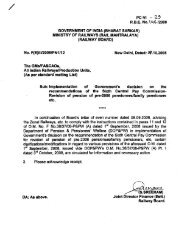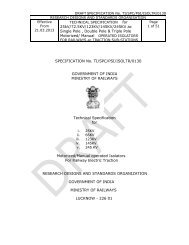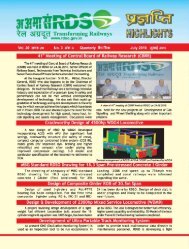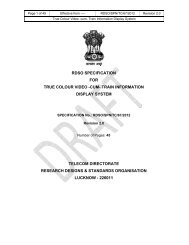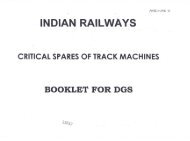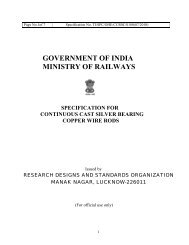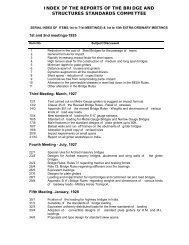Tender invited for Development of Train Collision Avoidance System
Tender invited for Development of Train Collision Avoidance System
Tender invited for Development of Train Collision Avoidance System
You also want an ePaper? Increase the reach of your titles
YUMPU automatically turns print PDFs into web optimized ePapers that Google loves.
ISO 9001: 2008 Effective from 18.06.2012 RDSO/SPN/196/2012 Version 3.1.1<br />
Document Title : Specification <strong>of</strong> <strong>Train</strong> <strong>Collision</strong> <strong>Avoidance</strong> <strong>System</strong><br />
3.2.10 First Stop Signal (FSS) - It is the first stop signal on approach to a station/<br />
IBS/ interlocked LC gate.<br />
3.2.11 Functional Acceptance Tests: Tests carried out by installing some<br />
equipments in the field to prove that the system per<strong>for</strong>ms in accordance with<br />
this specification & the local configuration data is acceptable.<br />
3.2.12 Interlocked LC Gate: An LC Gate interlocked with Signals. Such gates are<br />
protected though signals provided on trackside.<br />
3.2.13 Last Stop Signal: It is the last stop signal <strong>of</strong> a station/ IBS/ interlocked LC<br />
gate while leaving the station/ IBS/ interlocked LC gate.<br />
3.2.14 Level Crossing (LC):The intersection <strong>of</strong> road with railway track at the same<br />
level.<br />
3.2.15 Light Engine (LE): When the locomotive alone or consist <strong>of</strong> MU coupled<br />
locomotives runs as a train, the train is called as Light Engine.<br />
3.2.16 Locomotive: The word ‘locomotive’ wherever used in this specification shall<br />
also mean the driving cab <strong>of</strong> EMU, MEMU, DEMU or any other self-propelled<br />
vehicle running on Indian Railways.<br />
3.2.17 Mid-Section: A location on track anywhere in the block section.<br />
3.2.18 Movement Authority: The distance upto which the train is permitted to travel<br />
without danger.<br />
3.2.19 ‘Off’ aspect <strong>of</strong> a Signal: Any aspect other than ‘On’ aspect <strong>of</strong> a signal.<br />
3.2.20 ‘On’ aspect <strong>of</strong> a Signal: It is the most restrictive aspect <strong>of</strong> the signal. In case<br />
<strong>of</strong> stop signal, Red (or Danger) aspect is the ‘On’ aspect.<br />
3.2.21 Overlap Distance: The length <strong>of</strong> track in advance <strong>of</strong> a stop signal, which<br />
must be kept clear, either <strong>for</strong> clearing the stop signal next in rear or <strong>for</strong> the<br />
purpose <strong>of</strong> granting permission to approach. The overlap distance may be<br />
different <strong>for</strong> different types <strong>of</strong> signals & signalling.<br />
3.2.22 Point:A railroad switch, turnout or points is a mechanical installation enabling<br />
railway trains to be guided from one track to another. The position <strong>of</strong> the point<br />
is said to be ‘Normal’ if it is set to straight track & ‘Reverse’ if it is set to<br />
diversion.<br />
3.2.23 Routine Tests:Tests carried out on the equipment/ system by the<br />
manufacturer be<strong>for</strong>e <strong>of</strong>fering <strong>for</strong> inspection.<br />
3.2.24 Schedule <strong>of</strong> Dimensions (SOD): Indian Railways Schedule <strong>of</strong> Dimensions.<br />
SOD can be purchased from IR.<br />
3.2.25 Static speed pr<strong>of</strong>ile: The Static Speed Pr<strong>of</strong>ile (SSP) is a description <strong>of</strong> the<br />
fixed speed restrictions <strong>for</strong> a part <strong>of</strong> track sent from track to train.<br />
3.2.26 Station Section: It is that portion <strong>of</strong> station limits which can be used <strong>for</strong><br />
shunting even after granting Line clear to station in Rear.<br />
3.2.27 Stop Signal: A railway signal whose ON aspect is ‘Danger’.<br />
3.2.28 Traffic Direction: This is the direction <strong>of</strong> the train according to the traffic<br />
movement as decided by the railway <strong>for</strong> a particular section e.g. Up or Dn<br />
(down). This direction is used to determine head-on collision, Rear end<br />
collision, approaching or moving away from a train or station etc.<br />
3.2.29 <strong>Train</strong> Direction: This is the direction <strong>of</strong> the train as per Loco cab control e.g.<br />
Forward or Reverse or Neutral. This direction is used <strong>for</strong> determining roll<br />
back/ <strong>for</strong>ward, reverse movement etc.<br />
3.2.30 Type Tests: Tests carried out to prove con<strong>for</strong>mity with the specification.<br />
These are intended to prove the general qualities and design <strong>of</strong> the<br />
equipment/ system.<br />
Signal Directorate RDSO/Lucknow Page 11 <strong>of</strong> 56



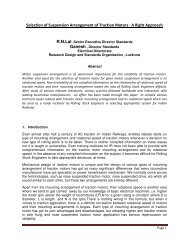

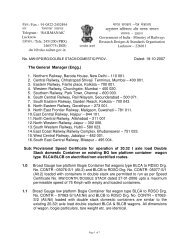
![Hkkjrljdkj] jsy ea= ky; vuql a/ kkuvfHkdYivkSj ekudlax Bu y ... - rdso](https://img.yumpu.com/21978459/1/184x260/hkkjrljdkj-jsy-ea-ky-vuql-a-kkuvfhkdyivksj-ekudlax-bu-y-rdso.jpg?quality=85)

